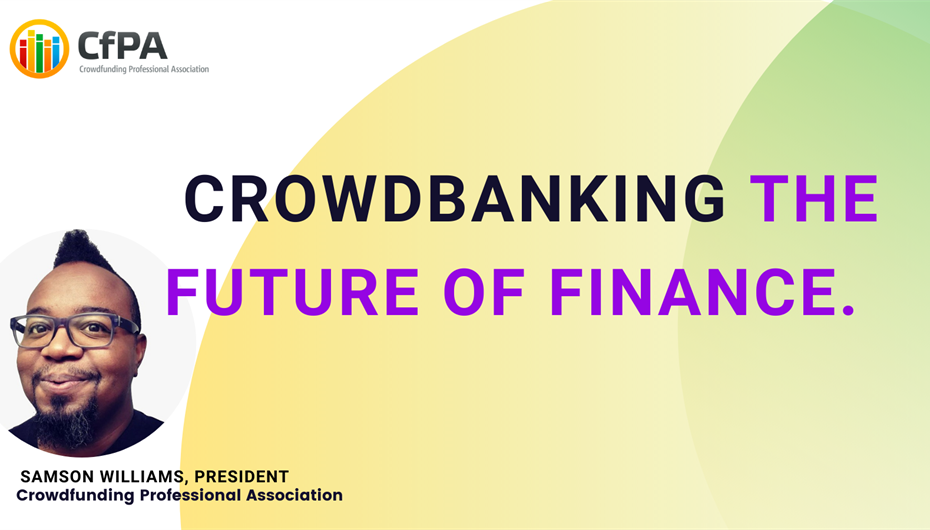The following article was written as part of a keynote I gave for a Banking and Payments Conference in Africa, to introduce Bankers to the art of the possible in the banking and payments industry.
“General Partners (GPs) crowdfund from Limited Partners (LPs).” - Samson Williams
As a financial anthropologist, I find Humans in Venture Capital fascinating. The humans in Venture Capital (VC) are different from the culture of Venture Capital. Yes, humans do come together to build and create the culture of VC. But individually they are unique, and able to operate and make independent decisions without regard to so-called cultural norms. I bring this up because one of the odd relics of VC culture is that nearly universally, these otherwise independent and autonomous humans engaged in Venture Capital, fall victim to a cancerous myth of VC culture. What is that myth of VC lore? The strongly held misconception that crowdfunding is a resource only for businesses who can’t secure or who aren’t worthy of VC money. This becomes an even more fundamentally baffling position when we consider exactly how VC’s fund Funds...through crowdfunding. Because did you know that GPs crowdfund from LPs...other VCs, Family Offices, and Institutions alike?
VCs Love Crowdfunding for FinTechs
Considering Venture Capital investments over the past decade, we discern that a disproportionate amount of investments have gone into “FinTech” or Financial Technology startups. Granted, at times data, data analytics, “Big Data,” machine learning, healthcare and what we’re going to colloquially refer to as “AI” companies also fall into the category of FinTechs. Ultimately financial technology is a broad arena, particularly when data is the main driver of calculating or providing goods, products, and services. In that case, nearly any technology that has a payment feature or enables the monetization of data could technically fall under the FinTech umbrella.
Despite the fluidity of the definition of what is and what isn’t FinTech, one of the undeniable attractions of this arena to VCs is that more often than not FinTechs handle the money. And history has shown it's a lot easier for a business to make money, when making money is your business. Guess who makes the most money off of making money? I’ll give you a hint: Those institutions that have historically made the most money are in the same vertical that VCs fund the most passionately, financial services. Who are those entities? Banks. Banks make money by making money...safer and more easily accessible. And this may also, coincidentally, be the very definition of “FinTech.” FinTech is financial technology that makes money safer and more easily accessible.
And thus, we come to the crux of this parable: If GPs crowdfund from LPs to invest in disruptive FinTech startups, who are the startups disrupting?
Banking Is A Verb
By this point your mind may be at war with itself. What we’ve discussed seems to make sense but may, to your otherwise rational mind, feel wrong. It feels wrong because there is still some uncertainty and doubt around crowdfunding. What even is crowdfunding and why would VCs deny engaging in it? And more importantly we all know that VCs don’t engage in crowdfunding from customers…
“VCs don’t crowdfund from customers?”
Say that out loud: “VCs don’t crowdfund from customers.” And, as you say that out loud your rational mind whispers back, “But VCs’ only “customers” are LPs, other funds and institutions. Sometimes even banks.” Startups aren’t VC’s customers. So, who exactly are VC’s customers?
Before we answer that, let's demystify crowdfunding so this all makes sense. Here is how you can spot a crowdfunding campaign from a thousand miles away. It must meet these three basic criteria.
- If you use the internet
- To solicit money
- From humans
You are crowdfunding. Granted there are nuances to the different types of crowdfunding. Sort of like how not all dogs are Dalmatians but Dalmatians are still dogs, as are Huskies, Shih Tzus and Poodles. So too with crowdfunding -- it comes in a few different types. Many people use the internet to solicit donations from humans. Donation crowdfunding is as old as tithing at church. Donation crowdfunding has just gone through its own digital transformation and is now a multi-billion-dollar online industry. Another type of crowdfunding is Rewards Based crowdfunding, which means you’re actually just pre-selling an item, typically at a reduced price. In America, you see crowdfunding platforms whose sole business model is enabling Reward Based crowdfunding campaigns.
The last types of crowdfunding fall under the umbrella of Investment Crowdfunding. Investment Crowdfunding is what VCs have been not so secretly doing for over 30 years by calling it syndication. It should be noted that the VC version of crowdfunding is also artificially limited to a select crowd by imposing administrative barriers that prevent customers, consumers, and everyday Humans from investing in their funds and deals. Amongst so called sophisticated Humans (Investors) this has become a hotly contested topic. Some will even get out the technical definition of syndication and yell from the top of their glass towers: “See! See! Using the internet to syndicate loans, real estate deals and funding rounds isn’t crowdfunding!”
Now that we have a better idea of what crowdfunding is, let's go back to answering the question, “Who are a VC’s customers?” VCs’ customers are the people and entities that they solicit money from, typically via internet platforms. Some famous VC crowdfunding platforms include Goldman Sachs’ Circle, OurCrowd, Silicon Valley Bank, Fundrise and AngelList, to name a few.
Appreciating that VCs have historically been crowdfunding from “accredited” and institutional investors, why does the statement “Banking is a verb” matter? Well, it turns out that if you’re crowdfunding billions of dollars, every year, from the wealthiest top 4% of the globe’s population, specifically to fund FinTechs, you already know and have put your money behind the simple premise of “Banking is a verb.” If you’re a bank (you’re a noun by the way) you should have a particular interest. Because what FinTechs do is make banking (the verb) easier, while leaving traditional banks on the hook for all the regulatory and compliance requirements of managing physical cash.
That's the thing when data becomes even more valuable than the commodities for which money is exchanged. All of a sudden hoteling works best without owning hotels (AirBnB), transportation companies work better without owning vehicles (Uber), and the verb that is banking becomes so much more profitable if you don’t ever have to actually touch the cash. Just ask Facebook.
The Future of Banking
In truth, we could have started here with these three simple bullet points:
- Banks will embrace crowdfunding as quickly as they embraced:
- Mobile banking
- Mobile payments
- Mobile investing
- Banks will embrace crowdfunding to avoid becoming solely useful as FinTech warehouses (FinTechs don’t actually want to incur the risk or operational headache of touching physical commodities like cash. After all, it gets a lot easier to make money when “money” is just data on a distributed ledger. Did someone just whisper blockchain?).
- As banks realize they have to compete with FinTechs (who are actually banks in the guise of social media networks and platforms like Facebook, Twitter, WeChat, ApplePay, etc.) with billions of daily users, who focus on getting Humans to spend more than a ⅓ of their waking hours a day on their platforms, banking (the verb) will be reimagined by Banks (the noun).
How Will Banks Reimagine Crowdbanking?
Imagine if you had a global bank that had been operating for over 150 years, in 20 countries, on one of the fastest growing continents on the planet. Now imagine if that bank, in addition to making banking possible, also had a mechanism to allow local people, international people and expats to invest directly into existing businesses and startups hailing from any of those 20 countries… Just like VCs might. Imagine what people would say. Imagine what customers would say. If, when they went to a local business to purchase something, they could just as easily pull out their phone and scan a QR Code and make the decision to invest in that business as well. Imagine the value added if a bank could keep their client’s investment portfolios within their banking ecosystem. What would happen if the population of 20 countries could safely and easily invest directly into businesses and startups at home?
So, how will banks reimagine crowdbanking? By inviting the crowd into banking, very similar to how GPs and Funds invite the crowd into funding.
Samson
About the Author
Samson Williams is an adjunct professor at Columbia University in NYC and the University of New Hampshire School of Law. When not exploring the realities of blockchain, cryptocurrencies and The Space Economy Samson is President of the Crowdfunding Professional Association, serial entrepreneur and investor who champions a very simple fact that, “Customers have more money than VCs.” For more information on Samson and the Fifth Industrial Revolution that is The Space Economy you can follow Samson on social at @HustleFundBaby.
Register for FREE to comment or continue reading this article. Already registered? Login here.
1


